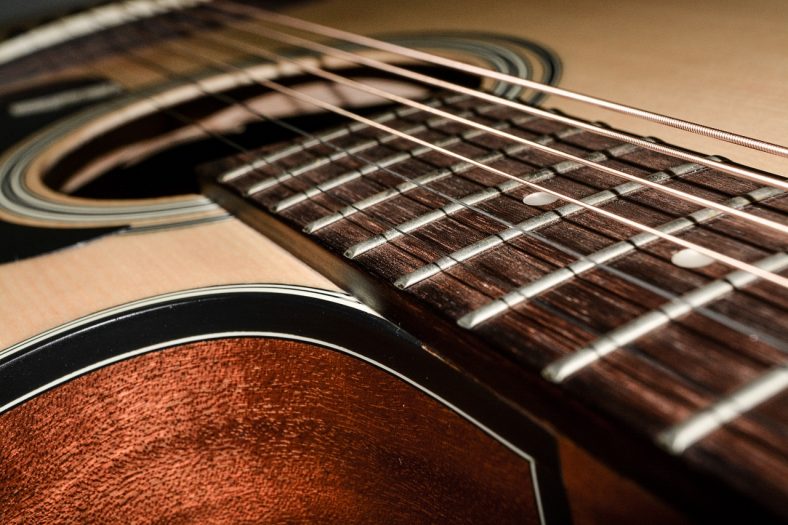
Restringing a guitar is not difficult at all. The procedure is quite similar for electric, acoustic, and classical guitars. It is quite simple to restring an electric guitar. Acoustic and classical guitars are a little more difficult, although they don’t always take much longer.
If you’re a beginner, the following are some of the equipment you’ll need. Wire cutters are the first and most important tool.
Also, a string winder seems like a very useful tool, which will speed up the whole process significantly.
Finally, get a tuner to finalize the whole process.
Contents
How to Restring an Electric Guitar

Compared to acoustic guitars, electric guitars require more frequent string changes. Because of that, these instruments feature mechanisms for quick and easy restringing. The whole process consists of note more than several steps.
First of all, you will have to remove the old ones. You can do this in two ways. The easier way is to cut the strings with a wire cutter. On the other side, you can unwind them from a tuning mechanism if you want to save those strings.
After you’re done with string removal, you can start with putting the new ones. The first step would be to anchor the string to the bridge. There are a few bridge types on electric guitars. Basically, we can classify them into two groups – hardtail and tremolo/Floyd rose bridges.
When it comes to hardtail design, passing the strings through the bridge is easy, since the wholes are highly transparent. On the other side, tremolo bridges (as well as some hardtail bridges) usually anchor strings into the body, so you will have to pass them from the backside.
It may sound complicated, but it is equally simple as with hardtail bridges. Finally, there is a Floyd Rose tremolo system, which seems a little bit more complicated, so we will talk another time about it.
The next step would be to draw the string over the saddle and top nut. Once you’ve reached tuning machines, pass the string through the tuning peg and keep it relatively tight. Use a string winder to tighten the string.
You don’t have to tighten it too much, just enough to keep it in the saddle. Repeat the process with the other five strings.
Now you can start with tuning. You can use a tuner, an online tuner, or rely on your ear, it doesn’t matter. Once you’re done with tuning, take a wire cutter and take off the excess length. That should be it.
Of course, consider that new strings have to stretch, so you will have to re-tune your guitar several times in the next few hours.
How to Restring an Acoustic Guitar

The restringing process of an acoustic guitar is pretty much the same as for the electric. There is probably just one tricky thing about it, which doesn’t necessarily have to be that complicated. Unlike electric guitars which come with various kinds of bridges, all acoustic guitars feature hardtails.
So what’s the catch? Many acoustic guitars feature the so-called pin anchor system. Basically, there are holes for each string and these pins keep them in place.
When removing old strings, you will have to pull out these pins. Some of these could be pretty stiff, so you can use a tool simply called a bridge pin puller. Once you remove the pins, take out old strings.
You can now insert new strings. Push the string ball through the hole and then push the pin you’ve removed before. Note that these pins feature some kind of cut-ins, which should house the string.
These cut-ins should be faced toward the guitar neck. Push the pins into these bridge holes, but don’t use too much force, you could cause some damage.
That should be the trickiest part of acoustic guitar restringing. The rest of the steps are the same as for electric guitar. Draw on the string all away up to machine tuners and pass the string through the tuning peg.
Once you’re done with winding, you can cut overmeasured part of the string. Repeat the process with other strings and then tune your guitar. Once again, count of frequent re-tunings in the first few hours.
How to Restring a Classical Guitar

Classical guitars are definitely trickiest to restring. Though the whole process isn’t that hard, there are a few things you should know about classical guitars.
First of all, these guitars feature nylon strings. The first three strings are completely made of nylon, while the other three feature nylon core, but metal winding around it. Compared to metal strings, these are less durable and lose their sound quality in a shorter time.
This means that you will have to change nylon strings more often. There are many clear signs that show it’s time for restringing. The obvious is oxidation.
Bass strings of classical guitars are usually wounded with silver, so the wires will get blacked after some time. Other indicators are when the copper starts to show through when one of the strings brakes etc.
Old nylon strings are pretty much useless, after restringing, so you can use wire cutters without worries. Once you take off old strings, there are a few tricky things you should know.
It’s not a big deal, just a few unique knots, considering that nylon strings don’t feature balls for bridge anchors and that winding roller on the headstock is a little bit different.
Here is a video that shows the most common knot for nylon strings:
You can try some other ways as well, but this is definitely the easiest one. The rest of the process is pretty much familiar and similar to an acoustic guitar.
Cleaning
Most guitar players practice guitar cleaning while restringing. It’s not necessary but it looks like a great opportunity to clean all those areas that can’t be reached while strings are on it. The whole cleaning process consists of a few steps. Basically, you have three different areas to clean.
The first one is a fingerboard. On most guitars, this area remains unfinished, without any varnish. So, it’s no wonder that many see it as a real dirt magnet.
It is probably the hardest part to clean. You will need a piece of fine sandpaper. However, you will have to be pretty gentle, to remove dirt but to keep the fingerboard untouched.
Once you finish with sandpaper work, you can use lemon oil to hydrate this dry piece of wood, which is mostly made of rosewood. You can also find numerous cleansers designed especially for guitar cleaning.
Another area that requires a lot of attention is the bridge. It features a lot of hard-accessible areas, so something like cotton swabs will work pretty well in this case.
The same goes for the headstock area. You can clean the whole headstock and it’s unreachable with cotton swabs. Also, a few drops of some oil for tuning machines would be highly beneficial.
Another important part of a guitar that people usually forget to clean is a nut. Take a piece of sandpaper and remove all the dirt. This will keep your guitar in tune for a much longer time.
It is very useful to clean the inside of an acoustic/classical guitar while strings are removed. Use dry cloth only, to prevent potential damages.
Finally, polish the guitar body. There are many products specially designed for polishing, but you don’t actually need them. Car wax works just fine in a combination with elbow grease. If you own a car, you probably have one in your garage.
For a more visual representation, you can check out this video:
Summary
Restringing is similar for all guitars. Electric, acoustic or classical, although there are some little differences, mostly concerning the bridge design. Nylon strings are easier to restring than metal ones and they lose quality faster than other types of guitar strings.
There are many products designed to hydrate the wood on a classical/acoustic guitar. You can use them or just go with lemon oil for easy tapping during the restringing process.
That’s it! It sounds really simple and that’s because it is. Nobody wants to spend a lot of time and energy while changing guitar strings. There is no rocket science in this process and you will be able to do it without any problems, as long as you keep in mind these few tips.





